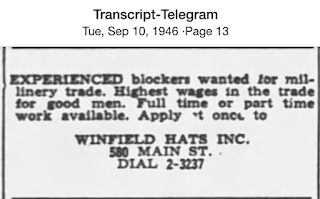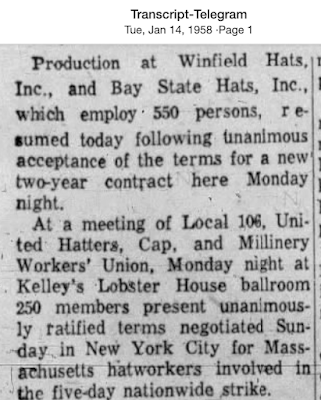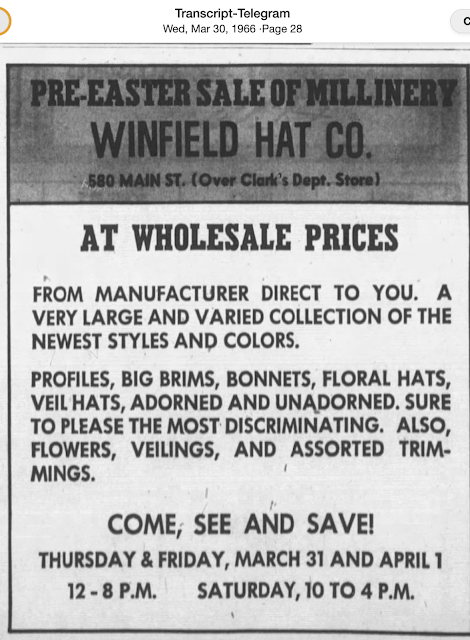Many of the businesses identified throughout this blog have ceased operating. This is a story about a company that closed down twice during its existence: the Winfield Hat Company.
The business was founded by Ben Freeman, who was employed by Bay State Hat Co. in Holyoke, and Arthur Schoer, an Army Air Force veteran. Mr. Freeman was the plant foreman and designer. Also designing was Florence Quinn, who would visit Holyoke to sketch her latest ideas from the fashion world. Mr. Schoer handled the business matters
The Winfield Hat Company began in early 1946 on the second floor of the former American Thread Co. factory at 580 Main Street. The company had 13,000 square feet of space in the building built in the late 1890s and owned by Charles Belsky. The company's sales office was in New York City.
The business began with 11 employees and, within five months, had grown to 26, producing 75 dozen hats daily. The finished products were sold through New York fashion houses to department stores and mail-order services.
Some of the materials used for the veils and braiding were imported from Italy, Czechoslovakia and Switzerland.
In 1951, a Christmas party was planned in the Valley Arena, as the company had 300 employees by its fifth year in business.
On August 22, 1956, the company opened a store within the mill to the public. The shop was called Winfield Mart. The latest hat styles were sold at discounted prices.
Many of the company's employees were members of the United Hatters, Cap and Millinery Workers of America Union. There were labor-management struggles along the way, which did lead to strike activity.
By 1957, both management and labor believed that employment could reach 400 that year. Although 11 years old at the time, Winfield Hat was thought to be the third-largest millinery company in the country. The prediction as to the number of employees was greatly exceeded, as the employment count was 550 in January 1958.
After a five-day strike, union members agreed to accept a new two-year contract in a meeting attended by 250 workers at Kelley's Lobster House ballroom.
By April 1965, the fashion world was changing, and Winfield Hats considered closing down, as hats were not selling. The 16-year-old company had been reduced to 30 employees. A going-out-of-business sale was held with substantially discounted prices. On May 8, 1965, its doors were closed.
However, union officials continued discussions with the owners concerning the possibility of reopening a restructured business. Concessions were made regarding wage reductions, and rehiring would be based on seniority. At this time, Louis Kweller was the company president, and Karl Zuckerman was its treasurer.
Six months after going out of business, Winfield Hats reopened in November 1965. At its inception, the workforce consisted of 25 employees. The opinion was that employment would increase to 150 within 6 months. The factory store was again operating.
By 1975, Winfield Hats was one of only two hat producers in New England. Although popular through the 1950s, the desire for hats waned in the late 1960s. Several factors contributed to this, including the phenomenon surrounding Jackie Kennedy. The first lady in the 1960s did not like wearing hats, and many followed her lead. Additionally, many hairstyles were not suitable for wearing hats. The advent of women's slacks and sportswear also contributed to the decline of hats. Wigs had taken the lead in headgear at this time.
A resurgence occurred in 1978, when stores such as Bloomingdale's, Macy's, Gimbels, and Lord and Taylor placed orders. The company was already supplying Sears & Roebuck and J. C. Penney. The company continued into the late 1980s and is shown as voluntarily dissolved by the Commonwealth of Massachusetts, Secretary of State's office in 1990.


























































No comments:
Post a Comment